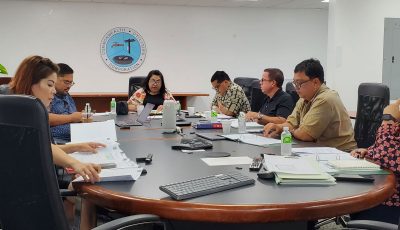Low water production hits some CUC water reservoirs
NWS warns of developing drought conditions in the Marianas
The water system of the Commonwealth Utilities Corp. has been plagued with a series of problems since December, ranging from significant leaks to low water production from the pumps to the tanks.
After the situation at the Calhoun reservoir and the loss of about a thousand-gallon per minute of water plus reduced water production at the Kannat Tabla tank last month, it’s now the Puerto Rico and Rapagao reservoirs that are having problems with production.
CUC announced limited water service for some of Saipan’s southern and western villages because of the low water levels in the Puerto Rico reservoir
“We lost production from wells,” CUC Water and Waste Water Department chief engineer John Riegel said in an interview, noting that the supply couldn’t keep up with the demand.
He said there’s going to be limited water supply in the areas being service by the tanks for the next couple of days.
“We should be back to, more or less, normal in Puerto Rico by the end of the week,” Riegel said.
In a press release, CUC said three wells that routinely pump water for the affected areas recently went offline, and the resulting drop in production hampered CUC’s ability to fill the Rapagao and Puerto Rico reservoirs.
The utilities company said their repair crews were able to bring one of the wells back online yesterday afternoon and will address the two remaining wells this morning.
CUC said customers in Garapan between Micro Beach Road and Orchid Street will receive water from 6am to 10am. Customers between Orchid Street and Garapan Street will receive water service from 10am to 2pm, while customers between Garapan Street and Gualo Rai Road will receive water service from 2pm to 6pm.
“In the south, customers in the Obyan area will also continue to receive limited service from 6am to 12pm as water personnel continue searching for suspected leaks in the main distribution lines that service the area,” CUC added.
Riegel noted that what happened to the Puerto Rico reservoir was identical to the problem encountered in Kannat Tabla—which although is now able to produce sufficient water for its service areas, repairs and replacement of some equipment are still needed.
“It’s the problem we have, we get one area fixed and then something breaks in another,” Riegel said.
There are about 140 water wells all around Saipan.
“Usually a well pump that is running as much as hours, you can get maybe five years average. But our water is more corrosive. Sometimes we need to replace them in just three years,” Riegel said.
Possible drought
Water system issues being aggravated by low water production could soon become a concern since the National Weather Service observed a very dry weather developing across the Mariana Islands.
According to a statement from NWS Guam, rainfall across the Marianas has been significantly below normal since November of last year and is expected to be below normal during the next several months.
“Computer models indicate rainfall of only a quarter inch to a half inch for the Mariana Islands through the next 10 days, and very low rainfall will likely persist through the next several months,” NWS said.
Currently, there is a drought statement in effect for Yap, the Republic of Palau and the Republic of the Marshall Islands. NWS said will likely be expanded to include the Mariana Islands in the coming weeks.
NWS said that dry weather and drought conditions across most of Micronesia are often associated with the latter phases of historically strong El Niño patterns. The El Niño pattern currently across the western north Pacific is expected to persist through the first half of 2016.
Already, NWS advised the public to be mindful of water usage.
“Water supplies will need to be monitored and water conservation is encouraged—especially for Saipan, Tinian, and Rota. Grass fires have already been observed in Guam and the risk of grass fires will increase in the coming weeks. Home owners should keep grass and brush trimmed far away from houses and other structures. Some damage to food crops could also develop,” NWS said.
Continued efforts
In a prior interview, acting CUC executive director Gary Camacho said they encourage the public to use water efficiently.
“We encourage people to use water efficiently and report leaks to the call center. We can only do this together as a team with the community to try to care for our essential resources which is water,” Camacho said, adding that call centers are always ready to receive reports of leaks.
He added that CUC is making efforts to improve the water service.
“CUC will continue its current effort to address some of the damage to the system and also try to upgrade certain areas to try to get back to more reliable water service,” Camacho said.
“With the Water Task Force being incorporated to the CUC program now, we anticipate that there will be a better and more prepared group of people capable of making the necessary repairs to better our service to the community,” he added.



























